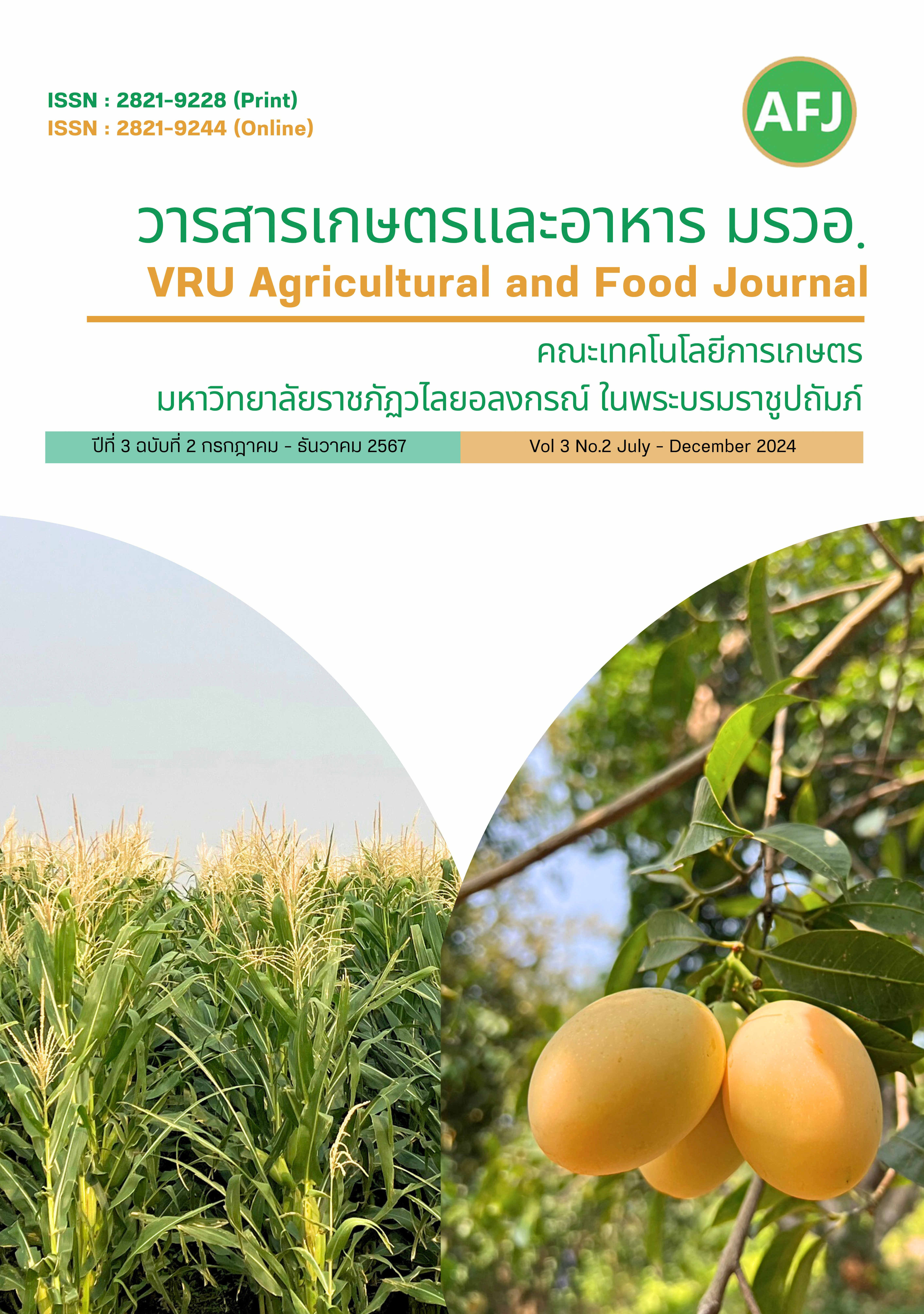ผลของการใช้ปุ๋ยไนโตรเจนที่มีต่อผลผลิตและคุณภาพเส้นใยของฝ้ายสายพันธุ์ก้าวหน้าที่ปลูกบนชุดดินวังไห
Main Article Content
บทคัดย่อ
ฝ้ายเป็นพืชเส้นใยที่สำคัญ ใช้เป็นวัตถุดิบสำหรับการผลิตสิ่งทอ การให้ผลผลิตขึ้นอยู่กับสายพันธุ์ฝ้าย และสภาพแวดล้อมโดยเฉพาะอย่างยิ่งปุ๋ยไนโตรเจนซึ่งมีความสำคัญต่อการเจริญเติบโต และเพิ่มผลผลิตของ จึงได้ศึกษาการใช้ปุ๋ยไนโตรเจนที่มีต่อผลผลิตและคุณภาพเส้นใยของฝ้ายสายพันธุ์ก้าวหน้า ที่ปลูกบนชุดดินวังไห วางแผนการทดลองแบบ Randomized Complete Block Design (RCBD) จำนวน 4 ซ้ำ ประกอบด้วย 5 กรรมวิธีทดลอง ได้แก่ กรรมวิธีทดลองที่ 1 ไม่ใส่ปุ๋ยไนโตรเจน กรรมวิธีทดลองที่ 2 - 5 ใส่ปุ๋ยไนโตรเจน 0.5 1.0 1.5 และ 2.0 เท่าของคำแนะนำตามค่าวิเคราะห์ดิน ตามลำดับ ผลการทดลองพบว่า การใส่ปุ๋ยไนโตรเจนส่งผลให้ความสูง ผลผลิต องค์ประกอบผลผลิต และคุณภาพของเส้นใย ของฝ้ายสายพันธุ์ก้าวหน้ามีค่าเพิ่มขึ้นอย่างมีนัยสำคัญทางสถิติเมื่อเปรียบเทียบกับการไม่ใส่ปุ๋ย ในขณะเดียวกันการใส่ปุ๋ยไนโตรเจนในอัตรา 0.5 เท่าของคำแนะนำ ส่งผลให้ฝ้ายสายพันธุ์ก้าวหน้า ให้ผลผลิต และมีความคุ้มค่าทางเศรษฐศาสตร์มากที่สุด ดังนั้น เพื่อผลิตฝ้ายสายพันธุ์ก้าวหน้า ให้ได้ผลผลิตสูง คุ้มค่าทางเศรษฐศาสตร์ และใช้ปุ๋ยได้อย่างมีประสิทธิภาพควรมีการวิเคราะห์ดินก่อนการปลูก และควรใส่ปุ๋ยไนโตรเจนในอัตรา 8-8-16 (N-P2O5-K2O) กก./ไร่
Article Details

อนุญาตภายใต้เงื่อนไข Creative Commons Attribution-NonCommercial-NoDerivatives 4.0 International License.
บทความนี้ได้รับการเผยแพร่ภายใต้สัญญาอนุญาต Creative Commons Attribution-NonCommercial-NoDerivatives 4.0 International (CC BY-NC-ND 4.0) ซึ่งอนุญาตให้ผู้อื่นสามารถแชร์บทความได้โดยให้เครดิตผู้เขียนและห้ามนำไปใช้เพื่อการค้าหรือดัดแปลง หากต้องการใช้งานซ้ำในลักษณะอื่น ๆ หรือการเผยแพร่ซ้ำ จำเป็นต้องได้รับอนุญาตจากวารสารเอกสารอ้างอิง
Ali, A., T. M. M. Ayub, I. Ali, A. Wasaya., and F. Khalid. 2009. Studies on the effect of plant spacing on the yield of recently approved varieties of cotton. Pak. J. Life Soc. Sci. 7: 25–30.
Agricultural Production Factors Research and Development Division. 2021. Recommendations for using fertilizer based on soil analysis values. For economic field crops. Department of Agriculture Ministry of Agriculture and Cooperatives, Bangkok. (in Thai)
Back, G. R., and K. H. Hartge. 1986. Bulk density. pp. 363-375. In: A. Klute, Ed. Methods of soil analysis. Part 1, Agronomy No.9, 2 nd ed. American Society of Agronomy, Madison, WI.
Borowski, E. 2001. The effect of nitrogenous compounds on the growth, photosynthesis and phosphorus uptake of sunflowers. In Proc. Ann. Univ. Mariae Curie-Sklodowska Sect. EEE Hortic. 9, 23–31.
Black, C.A. 1965. Method of soil analysis. Part A. Agronomy 9. American Society of AgronomyMadison, Wisconsin.
Cottenie, A. 1980. Soil and Plant Testing as a Basis of Fertilizer Recommendations. FAO Soil Bulletin 38/2. Food and Agriculture Organization of the United Nations, Rome.
Danso, M.T., Datta, R , Vranová and A. Ekielski. 2019. Ecotone Dynamics and Stability from Soil Perspective: Forest-Agriculture Land Transition. Agriculture 9, 228.
Department of Agriculture. 2002. Good agriculture suitable for cotton. Department of Agriculture Ministry of Agriculture and Cooperatives. 20 pages. (in Thai)
Faculty members of the Department of Soil Science. 2005. Introduction to agronomy. 10th printing. Bangkok: Kasetsart University Press. Kasetsart University. (in Thai)
Gardner, W. H.1982. Water content. Chapter 21 in Klute, A., ed. Methods of soil analysis. Part 1. Physical and mineralogical methods. 2nd Ed. Soil Science Society of America, Inc. Madison, Wisconsin
Office of Industrial Economics. 2009. Pairing Thai-Vietnamese textile industries. Hope to emerge as the king of ASEAN.Retrieved from: http://www.oie.go.th. April 22, 2009. (in Thai)
Owen, G., C. Chism C., and C., Jr. 2003. Managing earliness in cotton with mepiquat type growth regulators. Crop Manag. 2: 1–8.
Nakhon Sawan Field Crops Research Center. 2000. Cotton production knowledge. Data source: https://www.doa.go.th/fc/nakhonsawan/ Retrieved (July 24 2024). (in Thai)
Pattama, W. 2004. Advanced soil fertility. Department of Land and Environmental Resources Faculty of Agriculture Khon Kaen University. 423 pages. (in Thai)
Parinya, S. 2015. Research and improvement of cotton varieties with appropriate technology. In: Annual research report 2015. Nakhon Sawan Field Crops Research Center. Field Crops and Energy Renewable Crops Research Institute Department of Agriculture. (in Thai)
Pervaiz, Z., K. Hussain S.S.H. Kazmi and K.H. Gill 2004. Agronomic efficiency of different N:P ratios in rain fed wheat. International Journal of Agriculture & Biology 6(3): 455–457.
Supakarn, L., K. Phaisancharoen, and D. Khongthian. 2015. Study of response to fertilizer application of outstanding animal feed maize varieties in loamy soil areas. In: Annual research report 2015. Nakhon Sawan Field Crops Research Center. Research Institute for Field Crops and Alternative Energy Crops Department of Agriculture. (in Thai)
Walkley, A., and I.A. Black, 1934. An examination of the degtjareff method for determining soil organic matter and a proposed modification of the chromic acid titration method for determination of soil organic matter. Soil Science. 37: 29 – 33.
Zaman, I., M. Ali, K. Shahzad, M. saeed Tahir, A. Matloob, Ahmad, W.; Alamri, S. Alamri, M.R. Khurshid, M.M. Qureshi, A. Wasaya, K.S. Baig, M.H. Siddiqui, S. Fahad and R. Datta. 2021. Effect of Plant Spacings on Growth, Physiology, Yield and Fiber Quality Attributes of Cotton Genotypes under Nitrogen Fertilization. Agronomy 1:.1-15.
Zhao, W., Y. Wang, Z. Zhou, Y. Meng, B. Chen, and D.M. Oosterhuis. 2012. Effect of nitrogen rates and flowering dates on fiber quality of cotton (Gossypium hirsutum L.). J. Exp. Agric. Int. 2: 133–159.

